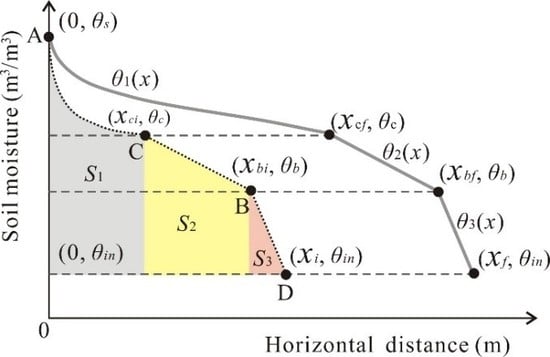Feasibility Investigation of Improving the Modified Green–Ampt Model for Treatment of Horizontal Infiltration in Soil
Abstract
1. Introduction
2. Improved Modified Green-Ampt Model
2.1. Theoretical Model Development
2.2. Setup of Calibration and Validation Tests
2.3. Parameter Determination Method
2.4. Numerical Model
3. Results and Discussion
3.1. Parameters Calibration Results
3.2. Infiltration Rate
3.3. Cumulative Infiltration
3.4. Unit Transfer Coefficient
3.5. Moisture Profiles of Different Soils during the Infiltration Process
3.6. Comparison between the IMGA Model and Solutions of Richards’ Equation
4. Conclusions
- The IMGA model enables accurate estimation of the soil moisture profile at any moment. The logarithmic function adopted by the IMGA model can capture changes in moisture content in the transition zone with a reflection of its decrease as the wetting front advances.
- By comparing the estimated cumulative infiltration data obtained using the models with those obtained by measurements, it was found that the IMGA model has the lowest relative error, followed by the MGA and GA models. It was also discovered that the relative errors of the models change with the infiltration time. The relative errors of the IMGA and MGA models monotonically decrease with time; however, for the GA model, the relative error first increases and then decreases. Therefore, the infiltration time should be specified when using this method to evaluate the errors of the models.
- It was demonstrated that the unit transfer coefficient can be inferred from the GA model using the mass conservation law. Soils with different compositions, grain size and structures also have different values, which can be determined by the method suggested in this study. The smaller the grain size, the larger is.
- Due to the unavoidable influence of interfaces and inhomogeneity in soil, the advancement distance of water infiltration calculated using Richards’ equation is shorter than that estimated by the IMGA model and the measured values. Another feature of the numerical solutions of Richards’ equation is that it is unable to reflect transmission zone, wetting zone, and demarcation point between these two zones. The horizontal soil moisture profiles obtained by the IMGA model is closer to the measured data than that of the numerical simulation results.
Author Contributions
Funding
Acknowledgments
Conflicts of Interest
Nomenclature and Abbreviations
| Nomenclature | |
| parameters that described soil moisture profile | |
| parameter of IMGA model related to infiltration time | |
| coefficient of gradation | |
| unit transfer coefficient | |
| uniformity coefficient | |
| soil water diffusivity (m2/s) | |
| ponding water head (m) | |
| cumulative infiltration (mm) | |
| cross-sectional area of the soil column (m2) | |
| parameters that described WF advancing velocity | |
| infiltration rate (mm/h) | |
| wetting front matric potential (kPa) | |
| radius of an idealized soil pore for fine soil (mm) | |
| elapsed time (h) | |
| surface tension of water (N/m2) | |
| temperature characteristic value (°C) | |
| V | total supplied water volume (m3/m3) |
| water advancement distance at the bottom of the polyvinyl chloride (PVC) column (m) | |
| advancement distance of the intersection point between the transmission zone and the wetting zone (m) | |
| advancement distance of the intersection point of two linear functions in the wetting zone (m) | |
| advancement distance of the WF (m) | |
| water advancement distance at the top of the PVC column (m) | |
| parameters that described relationship between and | |
| Greek letters | |
| unit weight of water | |
| relative error | |
| soil moisture (m3/m3) | |
| threshold moisture (m3/m3) | |
| soil moisture profile function in the transmission zone (m3/m3) | |
| soil moisture profile function collected with TZ in the wetting zone (m3/m3) | |
| soil moisture profile function collected with WF in the wetting zone (m3/m3) | |
| critical soil moisture in the middle of WZ (m3/m3) | |
| critical soil moisture between TZ and WZ (m3/m3) | |
| initial soil moisture (m3/m3) | |
| residual moisture (m3/m3) | |
| saturated soil moisture under a drying path (m3/m3) | |
| saturated soil moisture under a wetting path (m3/m3) | |
| soil matric suction (kPa) | |
| Acronyms | |
| AHFO | actively heated fiber optic |
| CFHC | carbon fiber heated cable |
| DMS | distributed moisture sensing |
| GA | Green–Ampt |
| MGA | modified Green–Ampt |
| IMGA | improved modified Green–Ampt |
| SWCC | soil water characteristic curve |
| TZ | transmission zone |
| WF | wetting front |
| WZ | wetting zone |
References
- Song, Y.; Lu, Y.; Guo, Z.; Xu, X.; Liu, T.; Wang, J.; Wang, W.J.; Hao, W.J. Variations in Soil Water Content and Evapotranspiration in Relation to Precipitation Pulses within Desert Steppe in Inner Mongolia, China. Water 2019, 11, 198. [Google Scholar] [CrossRef]
- Vidana Gamage, D.N.; Biswas, A.; Strachan, I.B. Field Water Balance Closure with Actively Heated Fiber-Optics and Point-Based Soil Water Sensors. Water 2019, 11, 135. [Google Scholar] [CrossRef]
- De Almeida, W.S.; Panachuki, E.; De Oliveira, P.T.S.; Da Silva Menezes, R.; Sobrinho, T.A.; De Carvalho, D.F. Effect of soil tillage and vegetal cover on soil water infiltration. Soil Tillage Res. 2018, 175, 130–138. [Google Scholar] [CrossRef]
- Liu, Z.; Ma, D.; Hu, W.; Li, X. Land use dependent variation of soil water infiltration characteristics and their scale-specific controls. Soil Tillage Res. 2018, 178, 139–149. [Google Scholar] [CrossRef]
- Cheik, S.; Bottinelli, N.; Soudan, B.; Harit, A.; Chaudhary, E.; Sukumar, R.; Jouquet, P. Effects of termite foraging activity on topsoil physical properties and water infiltration in Vertisol. Appl. Soil Ecol. 2019, 133, 132–137. [Google Scholar] [CrossRef]
- Weller, U.; Leuther, F.; Schlüter, S.; Vogel, H.J. Quantitative analysis of water infiltration in soil cores using x-ray. Vadose Zone J. 2018, 17, 17. [Google Scholar] [CrossRef]
- Toro-Guerrero, D.; Vivoni, E.; Kretzschmar, T.; Bullock Runquist, S.; Vázquez-González, R. Variations in Soil Water Content, Infiltration and Potential Recharge at Three Sites in a Mediterranean Mountainous Region of Baja California, Mexico. Water 2018, 10, 1844. [Google Scholar] [CrossRef]
- Yeh, H.F.; Tsai, Y.J. Effect of Variations in Long-Duration Rainfall Intensity on Unsaturated Slope Stability. Water 2018, 10, 479. [Google Scholar] [CrossRef]
- Mishra, S.K.; Tyagi, J.V.; Singh, V.P. Comparison of infiltration models. Hydrol. Processes 2003, 17, 2629–2652. [Google Scholar] [CrossRef]
- Cho, S.E.; Lee, S.R. Evaluation of surficial stability for homogeneous slopes considering rainfall characteristics. J. Geotech. Geoenviron. Eng. 2002, 128, 756–763. [Google Scholar] [CrossRef]
- Prevedello, C.L.; Loyola, J.M.T.; Reichardt, K.; Nielsen, D. New Analytic Solution Related to the Richards, Philip, and Green–Ampt Equations for Infiltration. Vadose Zone J. 2009, 8, 127–135. [Google Scholar] [CrossRef]
- Al–Maktoumi, A.; Kacimov, A.; Al–Ismaily, S.; Al-Busaidi, H.; Al-Saqri, S. Infiltration into Two–Layered Soil: The Green–Ampt and Averyanov Models Revisited. Transp. Porous Media 2015, 109, 169–193. [Google Scholar] [CrossRef]
- Zaibon, S.; Anderson, S.H.; Thompson, A.L.; Thompson, A.L.; Kitchen, N.R.; Gantzer, C.J.; Haruna, S.I. Soil water infiltration affected by topsoil thickness in row crop and switchgrass production systems. Geoderma 2017, 286, 46–53. [Google Scholar] [CrossRef]
- Ojha, R.; Corradini, C.; Morbidelli, R.; Govindaraju, R.S. Effective saturated hydraulic conductivity for representing field–scale infiltration and surface soil moisture in heterogeneous unsaturated soils subjected to rainfall events. Water 2017, 9, 134. [Google Scholar] [CrossRef]
- Stewart, R.D. A Dynamic Multidomain Green-Ampt Infiltration Model. Water Resour. Res. 2018, 54, 6844–6859. [Google Scholar] [CrossRef]
- Baiamonte, G.; Singh, V.P. Analytical solution of kinematic wave time of concentration for overland flow under Green–Ampt infiltration. J. Hydrol. Eng. 2015, 21, 04015072. [Google Scholar] [CrossRef]
- Grimaldi, S.; Petroselli, A.; Romano, N. Green-Ampt Curve-Number mixed procedure as an empirical tool for rainfall–runoff modelling in small and ungauged basins. Hydrol. Processes 2013, 27, 1253–1264. [Google Scholar] [CrossRef]
- Ma, D.; Zhang, J.; Lu, Y.; Wu, L.S.; Wang, Q. Derivation of the Relationships between Green–Ampt Model Parameters and Soil Hydraulic Properties. Soil Sci. Soc. Am. J. 2015, 79, 1030–1042. [Google Scholar] [CrossRef]
- Zema, D.A.; Labate, A.; Martino, D.; Zimbone, S.M. Comparing Different Infiltration Methods of the HEC–HMS Model: The Case Study of the Mésima Torrent (Southern Italy). Land Degrad. Dev. 2017, 28, 294–308. [Google Scholar] [CrossRef]
- Bouvier, C.; Bouchenaki, L.; Tramblay, Y. Comparison of SCS and Green-Ampt Distributed Models for Flood Modelling in a Small Cultivated Catchment in Senegal. Geosciences 2018, 8, 122. [Google Scholar] [CrossRef]
- Almedeij, J.; Esen, I.I. Modified Green–Ampt infiltration model for steady rainfall. J. Hydraul. Eng. 2014, 19, 0401410. [Google Scholar] [CrossRef]
- Tang, J.L.; Cheng, X.Q.; Zhu, B.; Gao, M.; Wang, T.; Zhang, X.; Zhao, P.; You, X. Rainfall and tillage impacts on soil erosion of sloping cropland with subtropical monsoon climate—a case study in central Sichuan Basin, China. J. Mt. Sci. 2015, 12, 134–144. [Google Scholar] [CrossRef]
- Xiang, L.; Ling, W.; Zhu, Y.; Chen, L.; Yu, Z. Self–adaptive Green–Ampt infiltration parameters obtained from measured moisture processes. Water Sci. Eng. 2016, 9, 256–264. [Google Scholar] [CrossRef]
- Deng, P.; Zhu, J. Analysis of effective Green–Ampt hydraulic parameters for vertically layered soils. J. Hydrol. 2016, 538, 705–712. [Google Scholar] [CrossRef]
- Chen, L.; Xiang, L.; Young, M.H.; Yin, Y.; Yu, Z.; Van Genuchten, M. Optimal parameters for the Green–Ampt infiltration model under rainfall conditions. J. Hydrol. Hydromech. 2015, 63, 93–101. [Google Scholar] [CrossRef]
- Ali, S.; Islam, A. Solution to Green–Ampt infiltration model using a two-step curve-fitting approach. Environ. Earth Sci. 2018, 77, 271. [Google Scholar] [CrossRef]
- Wu, S.; Shi, L.; Wang, R.; Tan, C.; Hu, D.; Mei, Y.; Xu, R. Zonation of the landslide hazards in the forereservoir region of the Three Gorges Project on the Yangtze River. Eng. Geol. 2001, 59, 51–58. [Google Scholar] [CrossRef]
- Kale, R.V.; Sahoo, B. Green–Ampt infiltration models for varied field conditions: A revisit. Water Resour. Manag. 2011, 25, 3505–3536. [Google Scholar] [CrossRef]
- Prevedello, C.L.; Loyola, J.M.; Reichardt, K.; Donald, N. New analytic solution of Boltzmann transform for horizontal water infiltration into sand. Vadose Zone J. 2008, 7, 1170–1177. [Google Scholar] [CrossRef]
- Prevedello, C.L.; Armindo, R.A. Generalization of the Green–Ampt Theory for Horizontal Infiltration into Homogeneous Soils. Vadose Zone J. 2016, 15, 1–10. [Google Scholar] [CrossRef]
- Philip, J.R. Numerical solution of equations of the diffusion type with diffusivity concentration–dependent. Trans. Faraday Soc. 1955, 51, 885–892. [Google Scholar] [CrossRef]
- Philip, J.R. Numerical Solution of Equations of the Diffusion Type with Diffusivity Concentration–Dependent II. Aust. J. Phys. 1957, 10, 29–42. [Google Scholar] [CrossRef]
- Barry, D.A.; Parlange, J.Y.; Prevedello, C.L.; Loyola, J.M.T. Extension of a recent method for obtaining exact solutions of the Bruce and Klute equation. Vadose Zone J. 2010, 9, 496–498. [Google Scholar] [CrossRef]
- Green, W.H.; Ampt, G.A. Studies on Soil Phyics. J. Agric. Sci. 1911, 4, 1–24. [Google Scholar] [CrossRef]
- Mao, L.; Li, Y.; Hao, W.; Zhou, X.; Xu, C.; Lei, T. A new method to estimate soil water infiltration based on a modified Green–Ampt model. Soil Tillage Res. 2016, 161, 31–37. [Google Scholar] [CrossRef]
- Hillel, D. Introduction to Environmental Soil Physics; Elsevier Academic Press: Amsterdam, The Netherlands, 2004; p. 110. [Google Scholar]
- Lu, N.; Godt, J.W. Hillslope Hydrology and Stability; Cambridge University Press: Cambridge, UK, 2013; p. 91. [Google Scholar]
- Sayde, C.; Gregory, C.; Gil-Rodriguez, M.; Tufillaro, N.; Tyler, S.; Van de Giesen, N.; English, M.; Cuenca, R.; Selker, J.S. Feasibility of soil moisture monitoring with heated fiber optics. Water Resour. Res. 2010, 46, 2840–2849. [Google Scholar] [CrossRef]
- Cao, D.F.; Shi, B.; Zhu, H.H.; Zhu, K.; Wei, G.Q.; Gu, K. Performance evaluation of two types of heated cables for distributed temperature sensing–based measurement of soil moisture content. J. Rock Mech. Geotech. Eng. 2016, 8, 212–217. [Google Scholar] [CrossRef]
- Sourbeer, J.J.; Loheide, S.P. Obstacles to long-term soil moisture monitoring with heated distributed temperature sensing. Hydrol. Processes 2016, 30, 1017–1035. [Google Scholar] [CrossRef]
- Benítez-Buelga, J.; Rodríguez-Sinobas, L.; Sánchez Calvo, R.; Gil-Rodríguez, M.; Sayde, C.; Selker, J.S. Calibration of soil moisture sensing with subsurface heated fiber optics using numerical simulation. Water Resour. Res. 2016, 52, 2985–2995. [Google Scholar] [CrossRef]
- Su, H.; Tian, S.; Cui, S.; Yang, M.; Wen, Z.; Xie, M. Distributed optical fiber-based theoretical and empirical methods monitoring hydraulic engineering subjected to seepage velocity. Opt. Fiber Technol. 2016, 31, 111–125. [Google Scholar] [CrossRef]
- Su, H.; Tian, S.; Kang, Y.; Xie, W. Monitoring water seepage velocity in dikes using distributed optical fiber temperature sensors. Autom. Constr. 2017, 76, 71–84. [Google Scholar] [CrossRef]
- Bai, F.Q.; Liu, S.H.; Yuan, J. Measurement of SWCC of Nanyang expansive soil using the filter paper method. Chin. J. Geotech. Eng. 2011, 33, 928–933. (In Chinese) [Google Scholar]
- Van Genuchten, M.T. A closed–form equation for predicting the hydraulic conductivity of unsaturated soils. Soil Sci. Soc. Am. J. 1980, 44, 892–898. [Google Scholar] [CrossRef]
- Cao, D.; Shi, B.; Zhu, H.; Wei, G.; Chen, S.; Yan, J. A distributed measurement method for in-situ soil moisture content by using carbon-fiber heated cable. J. Rock Mech. Geotech. Eng. 2015, 7, 700–707. [Google Scholar] [CrossRef]
- Sayde, C.; Buelga, J.B.; Rodriguez-Sinobas, L.; Khoury, L.; English, M.; van de Giesen, N.; Selker, J.S. Mapping variability of soil water content and flux across 1–1000 m scales using the actively heated fiber optic method. Water Resour. Res. 2014, 50, 7302–7317. [Google Scholar] [CrossRef]
- Brooks, R.H.; Corey, A.T. Hydraulic properties of porous media and their relation to drainage design. Trans. ASAE 1964, 7, 26–28. [Google Scholar]
- Carsel, R.F.; Parrish, R.S. Developing joint probability distributions of soil water retention characteristics. Water Resour. Res. 1988, 24, 755–769. [Google Scholar] [CrossRef]
- Pachepsky, Y.; Timlin, D.; Rawls, W. Generalized Richards’ equation to simulate water transport in unsaturated soils. J. Hydrol. 2003, 272, 3–13. [Google Scholar] [CrossRef]
- Płociniczak, Ł. Analytical studies of a time-fractional porous medium equation. Derivation, approximation and applications. Commun. Nonlinear Sci. Numer. Simul. 2015, 24, 169–183. [Google Scholar] [CrossRef]
- Xiao, H.; Huang, J. Experimental study of the applications of fiber optic distributed temperature sensors in detecting seepage in soils. Geotech. Test. J. 2013, 36, 360–368. [Google Scholar] [CrossRef]
- Herrada, M.A.; Gutiérrez-Martin, A.; Montanero, J.M. Modeling infiltration rates in a saturated/unsaturated soil under the free draining condition. J. Hydrol. 2014, 515, 10–15. [Google Scholar] [CrossRef]
- Leong, E.C.; Rahardjo, H. Review of soil–water characteristic curve equations. J. Geotech. Geoenviron. Eng. 1997, 123, 1106–1117. [Google Scholar] [CrossRef]
- Likos, W.J.; Lu, N.; Godt, J.W. Hysteresis and uncertainty in soil water–retention curve parameters. J. Geotech. Geoenviron. Eng. 2013, 140, 1–11. [Google Scholar] [CrossRef]
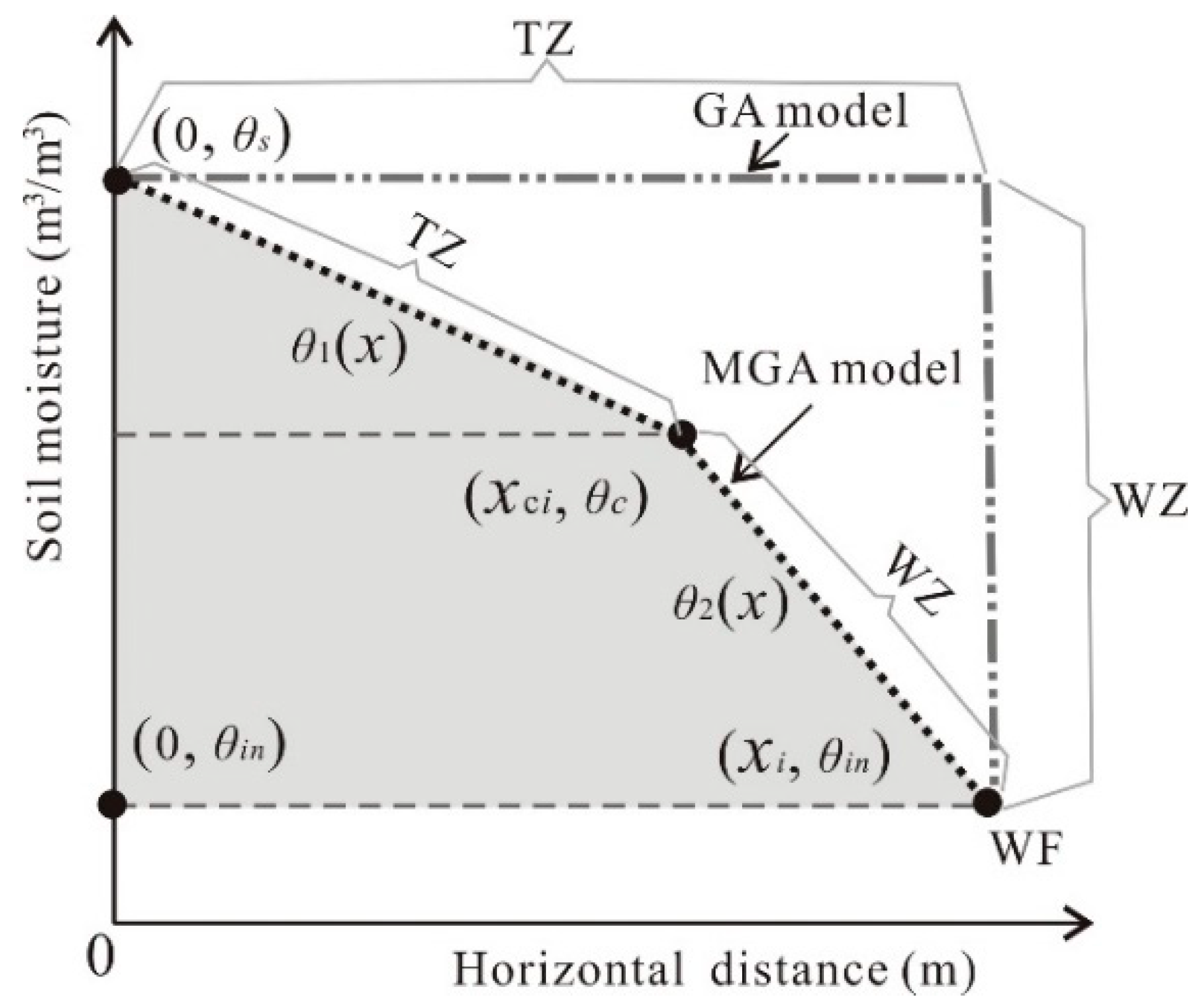

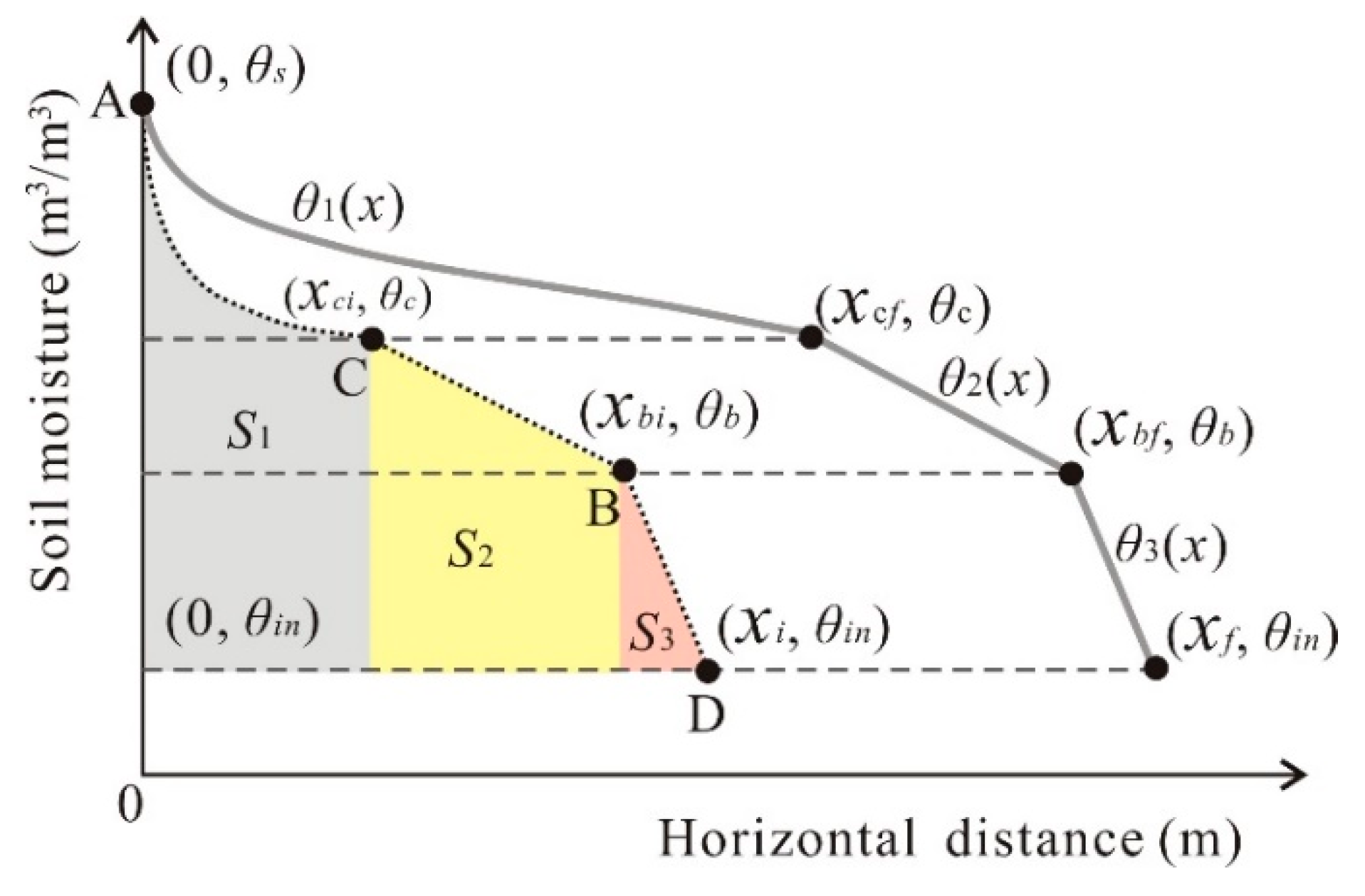
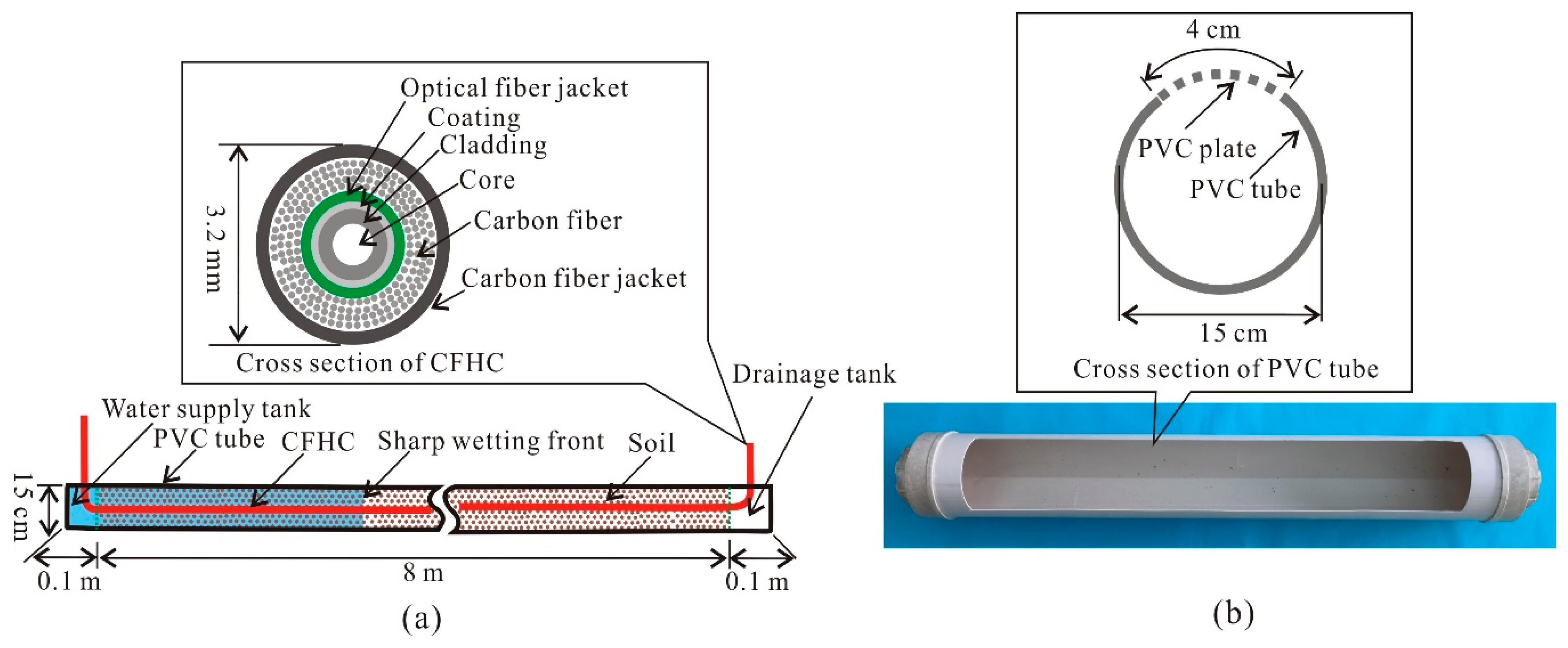
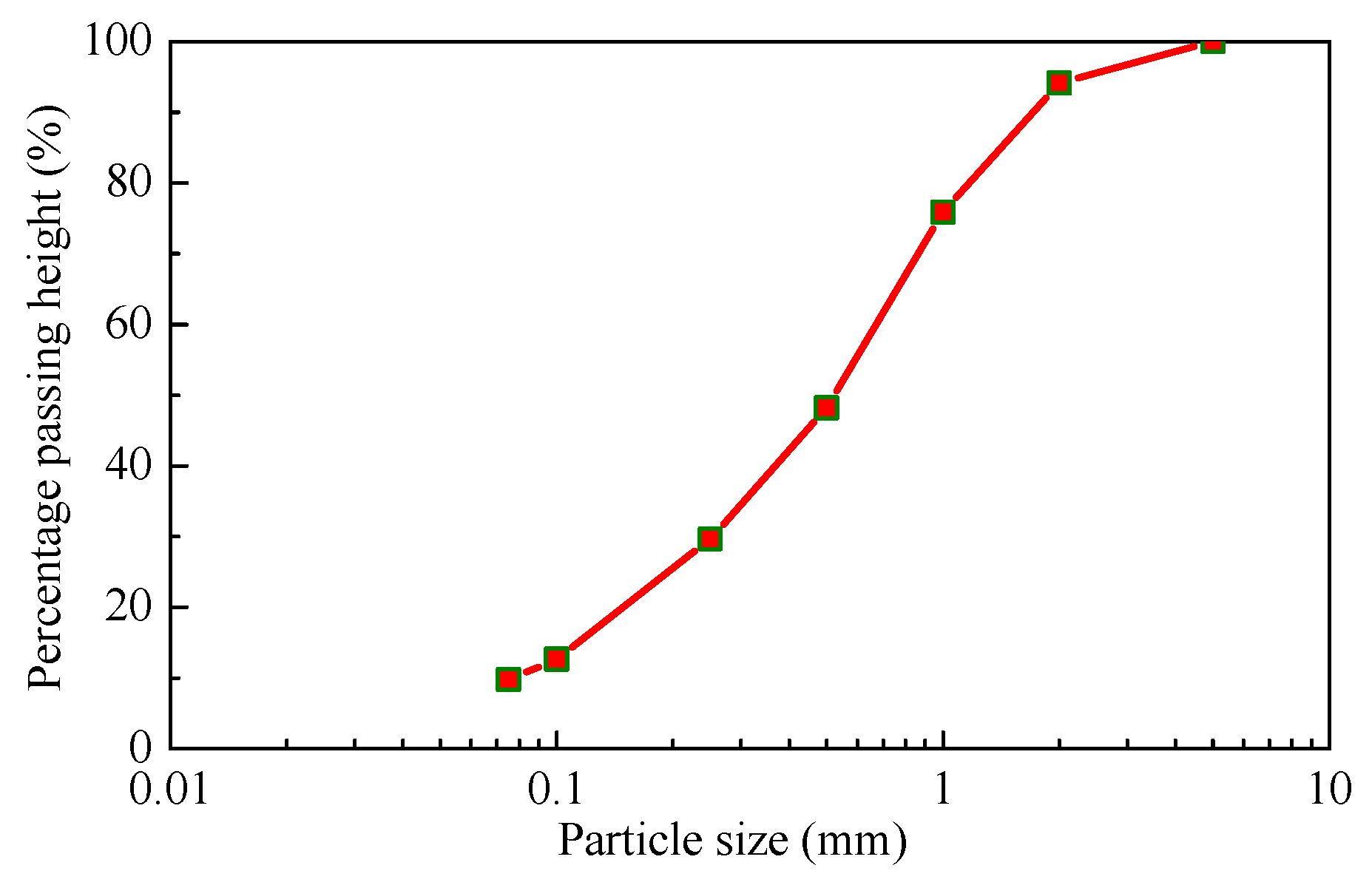
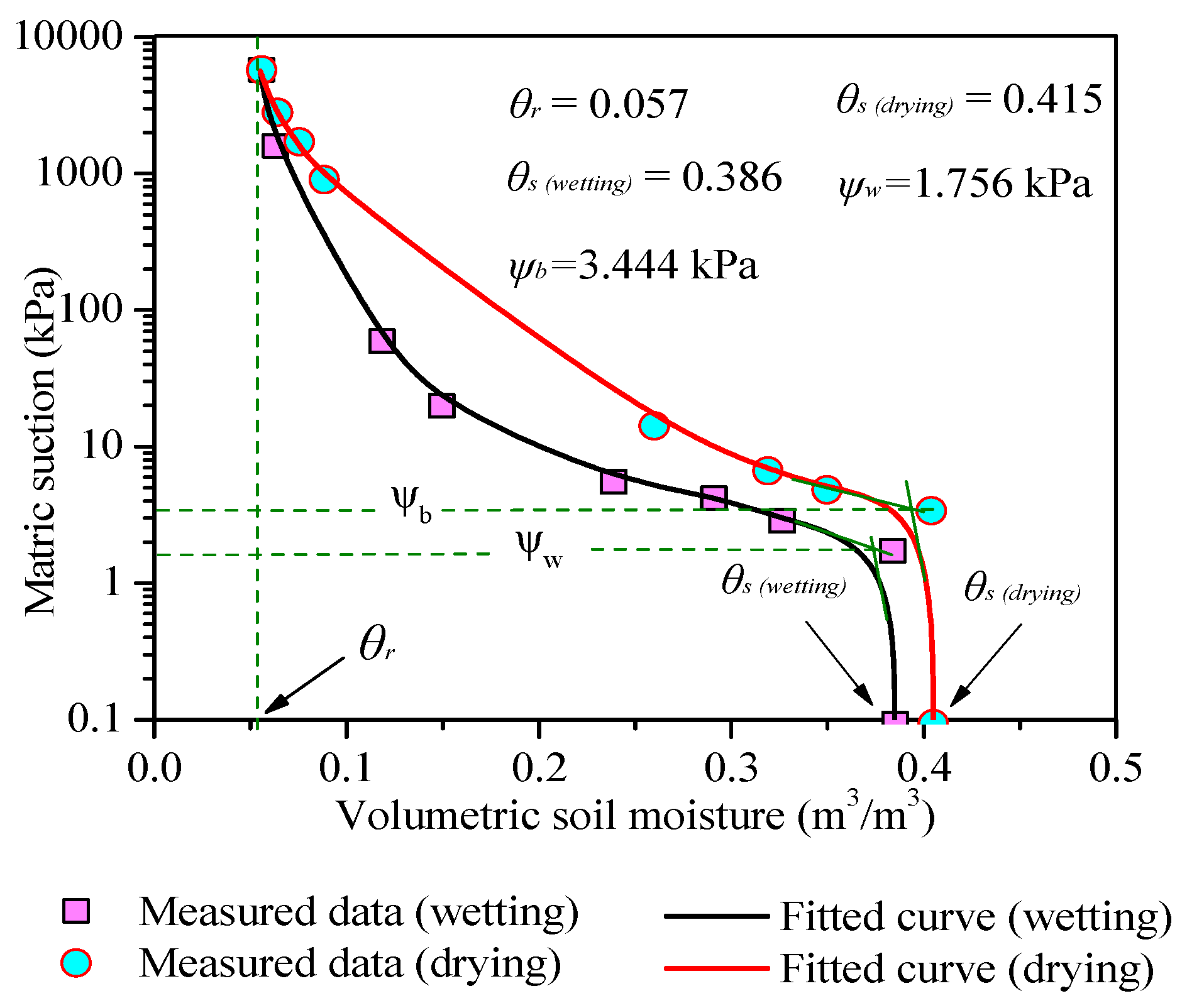
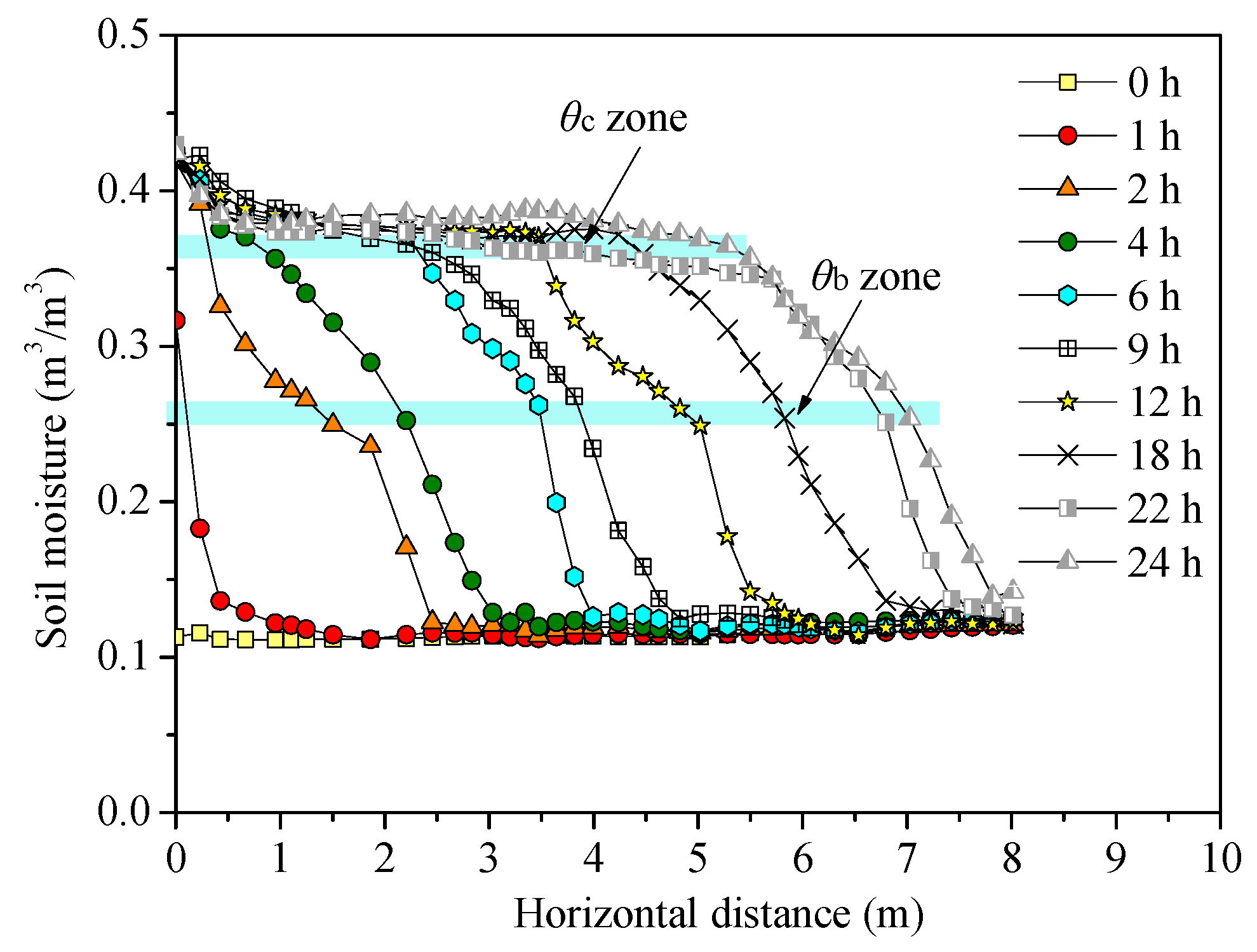
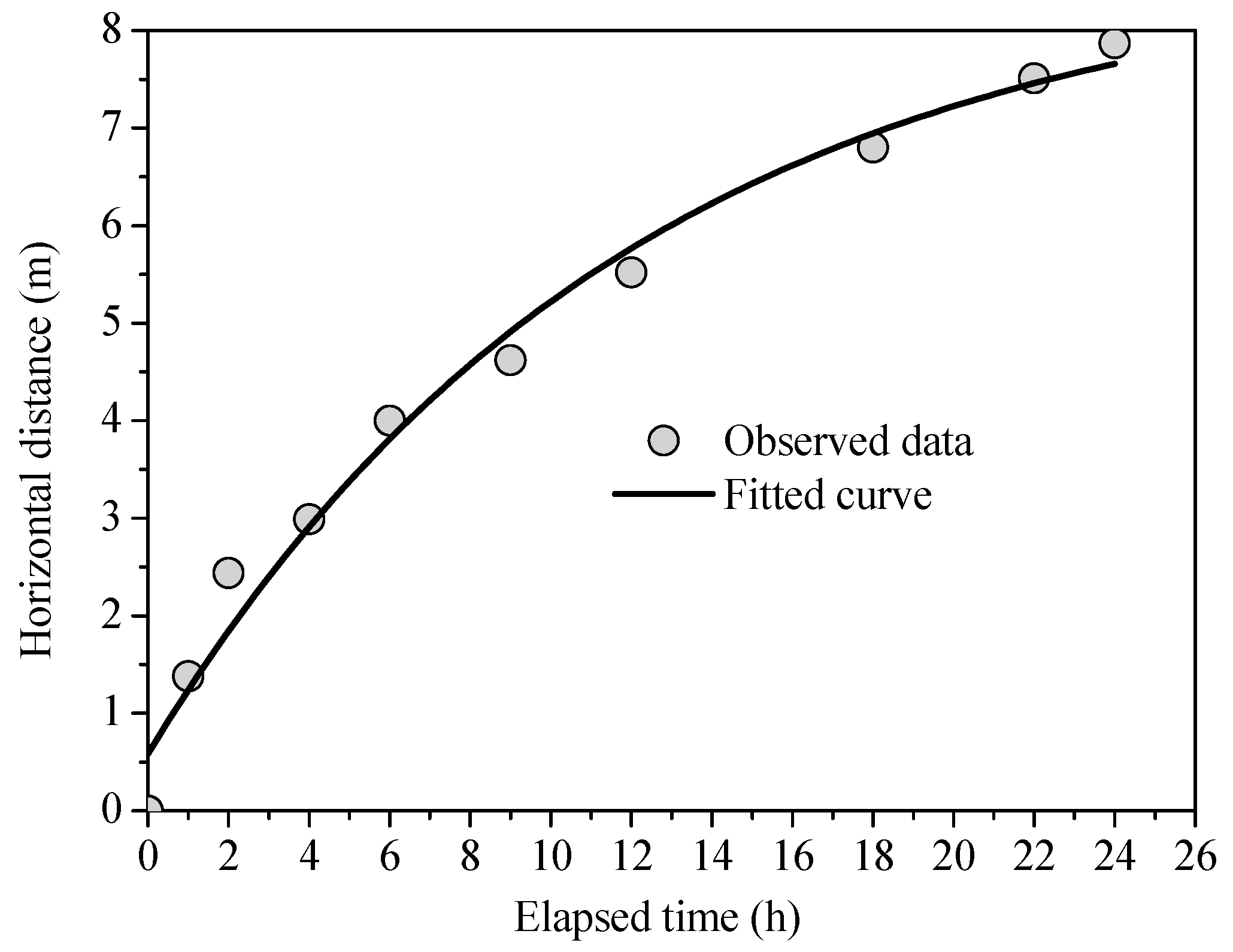
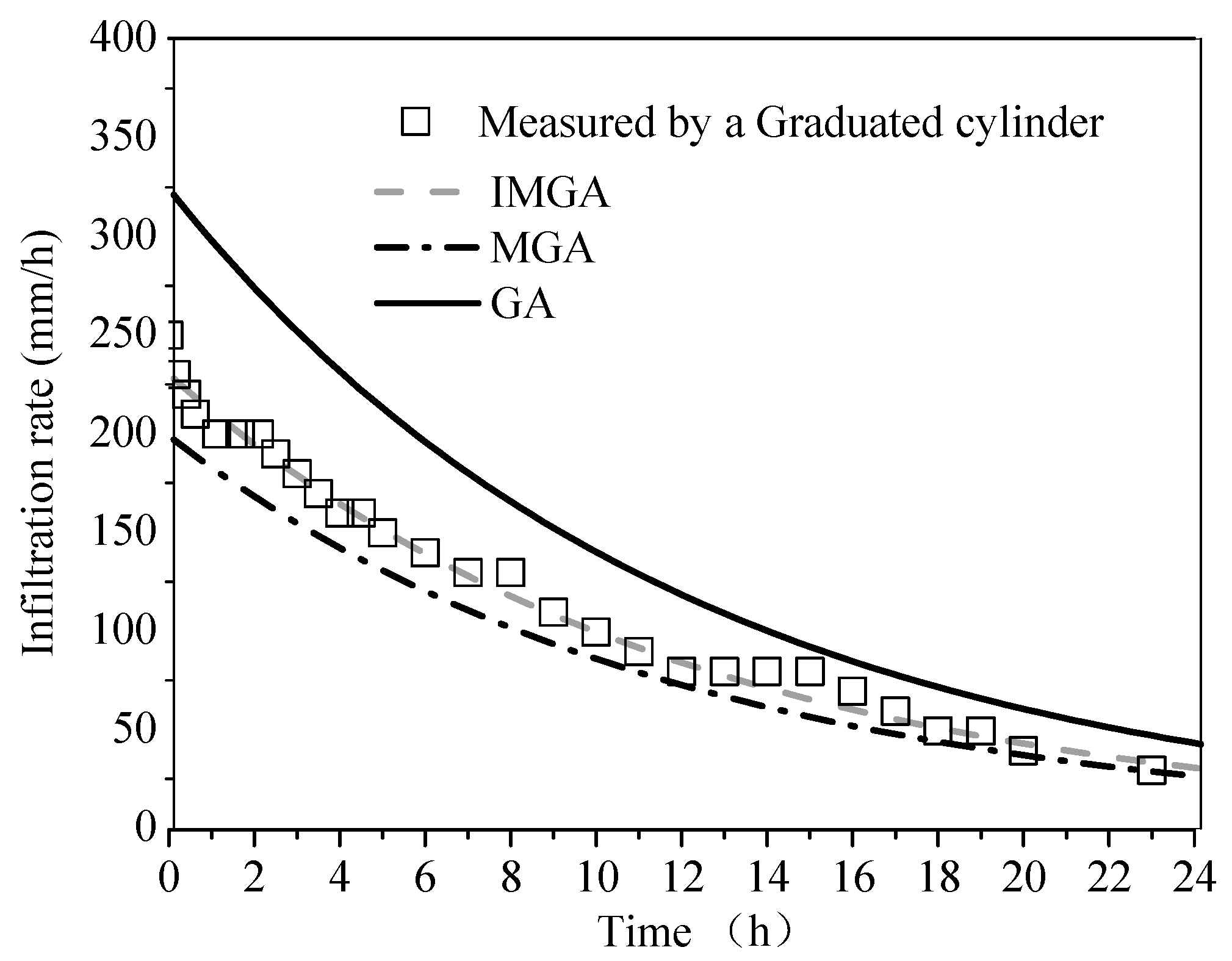
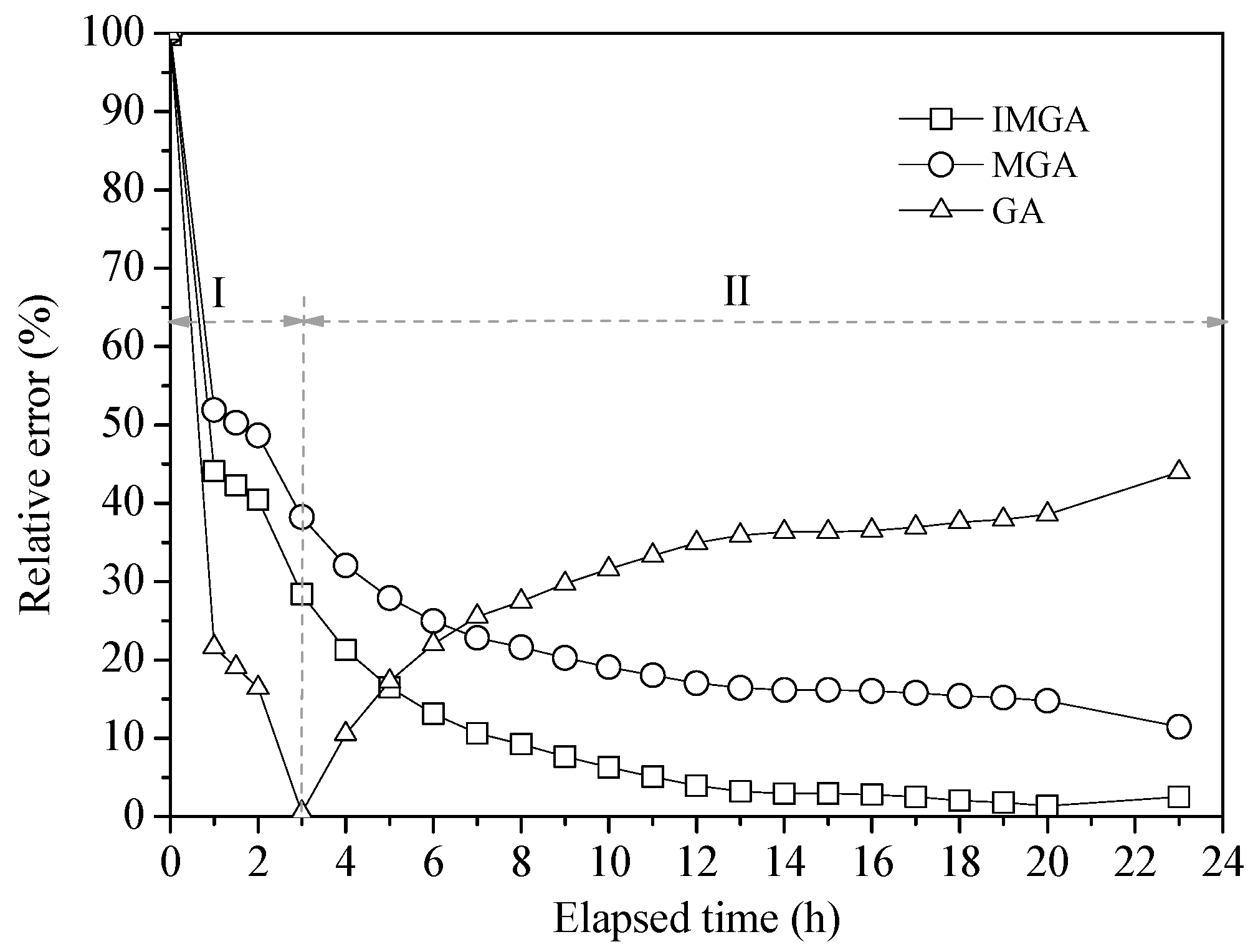

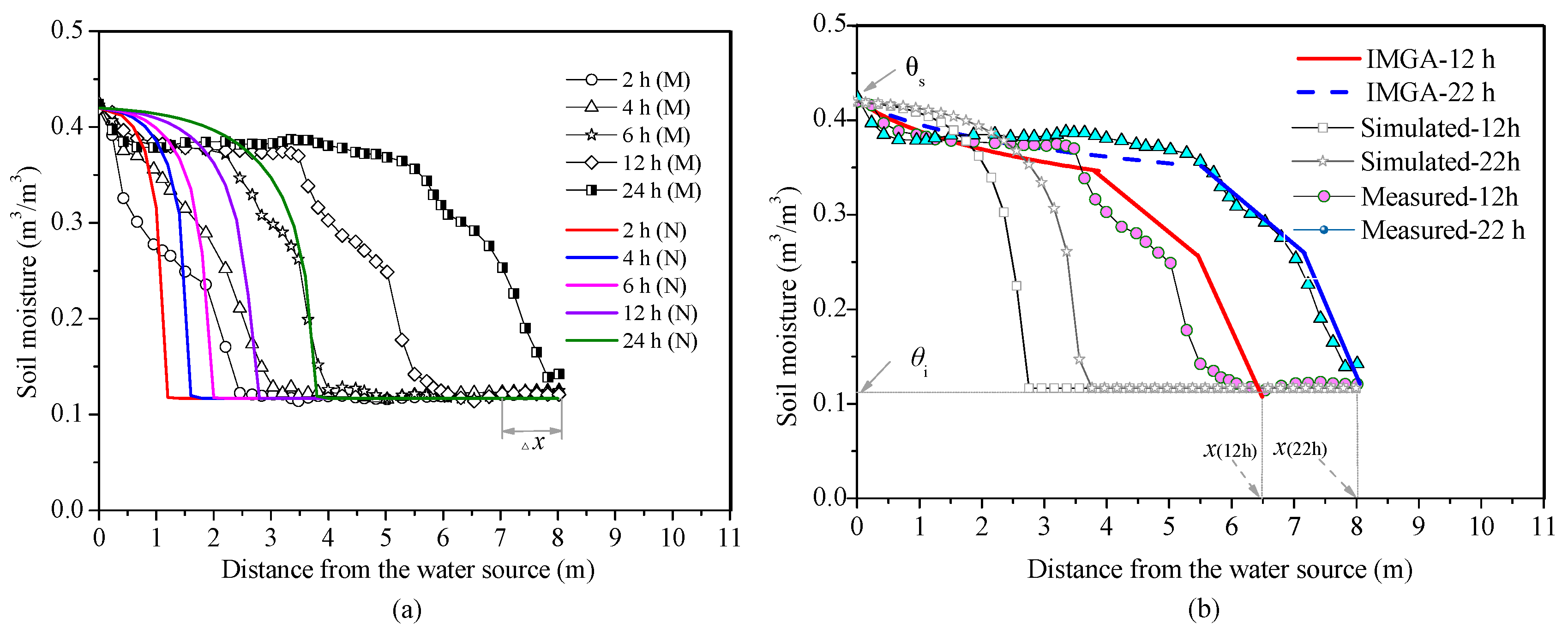
| Performance Parameters | Values |
|---|---|
| Distance measurement range (km) | 0 to 50 |
| Temperature measurement range (°C) | −40 to 120 |
| Soil moisture measurement range (m3/m3) | 0 to 0.65 |
| Maximum current (A) | 10 |
| Fiber type | Multimode (50/125) |
| Moisture accuracy (m3/m3) | 0.02 |
| Response time (min) | 20 |
| Spatial resolution (m) | 0.31 |
| Sampling interval (m) | 0.2 |
| Channel number | 2 |
| Power consumption (W) | 0 to 2000 |
| Soil | Θs (m3/m3) | Θr (m3/m3) | A (1/m) | N | I | Ks (m/s) |
|---|---|---|---|---|---|---|
| Sand | 0.41 | 0.055 | 7.5 | 1.89 | 0.5 | 6.379 × 10−4 |
| Soil Type | θs (m3/m3) | θc (m3/m3) | θb (m3/m3) | xi − xbi (cm) | xbi − xci (cm) | R2 (MGA) | R2 (IMGA) | |
|---|---|---|---|---|---|---|---|---|
| Soil used in this test | 0.416 | 0.332 | 0.253 | 39.57 | 149.62 | 0.834 | 0.927 | |
| Soils used by Mao | BJ | 0.451 | 0.245 | 0.325 | 1.12 | 5.38 | 0.954 | 0.982 |
| AS | 0.487 | 0.363 | 0.327 | 2.91 | 4.86 | 0.859 | 0.996 | |
| YL | 0.512 | 0.396 | 0.389 | 2.27 | 9.47 | 0.975 | 0.991 | |
© 2019 by the authors. Licensee MDPI, Basel, Switzerland. This article is an open access article distributed under the terms and conditions of the Creative Commons Attribution (CC BY) license (http://creativecommons.org/licenses/by/4.0/).
Share and Cite
Cao, D.-f.; Shi, B.; Zhu, H.-h.; Inyang, H.; Wei, G.-q.; Zhang, Y.; Tang, C.-s. Feasibility Investigation of Improving the Modified Green–Ampt Model for Treatment of Horizontal Infiltration in Soil. Water 2019, 11, 645. https://doi.org/10.3390/w11040645
Cao D-f, Shi B, Zhu H-h, Inyang H, Wei G-q, Zhang Y, Tang C-s. Feasibility Investigation of Improving the Modified Green–Ampt Model for Treatment of Horizontal Infiltration in Soil. Water. 2019; 11(4):645. https://doi.org/10.3390/w11040645
Chicago/Turabian StyleCao, Ding-feng, Bin Shi, Hong-hu Zhu, Hilary Inyang, Guang-qing Wei, Yan Zhang, and Chao-sheng Tang. 2019. "Feasibility Investigation of Improving the Modified Green–Ampt Model for Treatment of Horizontal Infiltration in Soil" Water 11, no. 4: 645. https://doi.org/10.3390/w11040645
APA StyleCao, D.-f., Shi, B., Zhu, H.-h., Inyang, H., Wei, G.-q., Zhang, Y., & Tang, C.-s. (2019). Feasibility Investigation of Improving the Modified Green–Ampt Model for Treatment of Horizontal Infiltration in Soil. Water, 11(4), 645. https://doi.org/10.3390/w11040645






